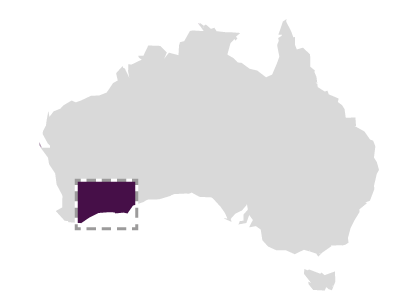Fairy (1849/06/12)
Princess Royal Harbour, Albany

Fairy is a vessel about which there is much confusion. Because it was never registered, this confusion is likely to continue. It was built either by Captain Thomas Symers (Garden, 1977: 101 and Dickson, 1999: 266) or for Captain Symers (Henderson 2007: 301 and Marshall, 2001: 155). What is not in dispute is the location of building on the banks of the Kalgan River, about a mile upstream from the mouth. If the Henderson/Marshall information is correct, the builders would have been Solomon Cook, Mr Metcalf and Mr Covert (Captain James Sale, quoted in Marshal, 2001: 155). Building using local jarrah commenced in 1844, but was very slow due to financial problems faced by Symers, so on 17 December 1849 he took two partners into the project, John Thomas and James Dunn.
There is further confusion over the rig. While Captain Sale stated that the vessel was to have been rigged as a brig (Marshall, 2001: 155), others state that it was rigged as a schooner (Dickson, 1998: 266 and Henderson, 2007: 301). In a letter from Symers to his agent in Perth declining the offer of buying a block of land that he badly wanted, he stated:
I am sorry to say that I cannot purchase land at present, the whole of my ready money being on the schooner - £750 worth and still wanting sails and an anchor and cable to complete her (Glover, 1953: 87).
While Dunn contributed finance, it may be presumed that Captain Symers intended to command the vessel himself. At the time of its loss the Fairy was moored in Princess Royal Harbour, having been brought from Oyster Harbour on 13 June 1850 by Dunn.
THE LOSS
A disagreement arose over ownership and payment for the work needed to complete the fitting out of the Fairy. In October 1850 James Dunn sent a petition to the Governor requesting arbitration. The Governor declined to become involved, describing the dispute as a commercial matter. The dispute appears to have remained unresolved, leading to the abandonment and subsequent loss of the vessel. There are a number of differing versions as to the exact sequence of events that led up to this loss:
1. The mooring rope was cut, allowing the vessel to drift onto a sand bank where its back was broken (Stan Austen, quoted in Marshall, 2001: 154).
2. The vessel was left as a derelict and broke its mooring and washed ashore (Howard Hartmann, quoted in Henderson, 2007: 302).
3. The vessel just rotted away at its mooring (Dickson, 1998: 266 and Captain Sale, quoted in Marshall, 2001: 155).
SITE LOCATION
The wreck of the Fairy lies almost on the 2-metre contour towards the western end of Princess Royal Harbour, directly south of the old wool stores.
SITE DESCRIPTION
The wreck of the Fairy lies on a north-west/south-east axis, possibly with the stern to the south-east. A keel (16.75 m long and canted about 45º to the north-east) and six floors are visible, together with a timber which is most probably a stern post. Scattered timbers including a knee, fashion piece and pulley sheave lie close to this, as does a ballast mound 11.2 m long and 2.7 m in width. The site is covered in sea grass and shifting sand patches.
EXCAVATION AND ARTEFACTS
A wreck inspection in 1991 by Dr Michael McCarthy and Patrick Baker, Maritime Archaeology Department, Western Australian Museum, recovered a double pulley sheave with iron bearings. During a further wreck inspection conducted by McCarthy the following year a sample of timber was taken which on analysis proved to be jarrah (Eucalyptus marginata).
STATEMENT OF SIGNIFICANCE
SOCIAL (3)
Captain Thomas Lyell Seymour-Symers’ (he later dropped the hyphen) had served with the Honourable East India Company, and arrived in Albany on 1 June 1835.
The Fairy was the third vessel owned by Symers. His first was the 189-ton barque Caledonia, built in Coringa, India. The second was a 50-ton schooner which he commenced building on the Kalgan River in 1835 (Glover, 1953: 75).
The stern post of the wreck of the Fairy projected above water level for many years and was a favourite fishing spot, referred to as ‘Rudder Head’ or ‘Fairy Spit’.
Fairy (1844-1850)
Construction of the Fairy commenced in 1844. Contractors Solomon Cook, Mr Metcalf and Mr Covert built it on the bank of the Kalgan River for Captain Symers. Unfortunately the vessel’s construction dragged on until the end of the 1840s, delayed by Symers’ financial difficulties, and a dispute over the rigging of the vessel between Symers and one of his new business partners, James Dunn. During the dispute work stopped and the vessel sat unused in Princess Royal Harbour. In 1850 the Fairy was blown from its moorings onto a shallow sandbank (another report says that its mooring rope was cut) where the wreck remains to this day. An archaeological survey by the WA Museum in 1991 located hull timbers, ballast and a pulley sheave indicating it was likely to have been rigged at the time of its wrecking. The Fairy has been described as both a schooner and a brig, of between 100-150 tons.
Alhough it never left Albany, the wreck of the Fairy is significant as one of Western Australia’s earliest examples of local shipbuilding, and warrants further study.
Ship Built
Owner Symers and Dunn
Builder Captain Thomas Symers
Country Built WA
Port Built Albany, Kalgan River
When Built 1849 ( starting 1844)
Ship Lost
Grouped Region South-Coast
Sinking ship was never completed but allowed to rot
When Lost 1849/06/12
Where Lost Princess Royal Harbour, Albany
Latitude -35.0385
Longitude 117.8606666667
Position Information GPS
Cargo No cargo
Ship Details
Engine N
TONA 70.00
Museum Reference
Unique Number 223
Sunk Code Abandoned
File Number 2009/0114/SG _MA-9/92
Chart Number AUS 109
Protected Protected State
Found Y
Inspected Y
Date Inspected 1991/07
Confidential NO